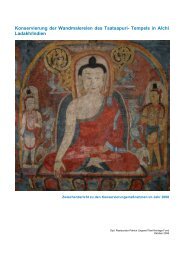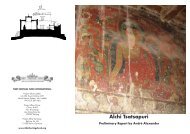Beijing Hutong Conservation Plan - Tibet Heritage Fund
Beijing Hutong Conservation Plan - Tibet Heritage Fund
Beijing Hutong Conservation Plan - Tibet Heritage Fund
You also want an ePaper? Increase the reach of your titles
YUMPU automatically turns print PDFs into web optimized ePapers that Google loves.
54<br />
5.3 Cooperation between residents, officials and experts<br />
Residential communities are now recognised as being an integral component of any historic area. Many international projects such as the IBA in Berlin, the<br />
Main Street Program in the USA and the rehabilitation of the Zanzibar have demonstrated the succesful use of community-based area rehabilitation. The<br />
<strong>Hutong</strong> survey confirmed that the present resident community is deep-rooted and is inseparable from the atmosphere of the old city. <strong>Beijing</strong> already has one<br />
of the world’s largest out-door museums, the Forbidden City. The <strong>Hutong</strong>s now have a unique vitality, which will be destroyed if they too are made into<br />
museum towns.<br />
In the Ya er <strong>Hutong</strong> area, an attempt has already been made to re-establish one family courtyards by relocating present residents and redeveloping the<br />
courtyards for wealthy families. So far, this has not been economically successful. One of the problems with this solution has been that the lifestyle of today’s<br />
wealthy owners no longer fits into the <strong>Hutong</strong> community. The wealthy tend not to use local shops and markets, keep their gates locked and use the private<br />
cars to get around. Thus they contribute little to the local community (and bereaving <strong>Beijing</strong> of one of its tourist attractions) whilst overstressing the transport<br />
infrastructure - the Yuan Dynasty lanes. Over the past century, a feudalistic system has transformed into a popular social community. To forcefully remove<br />
thousands of residents for the benefit of a few owners would harm this social system and create a feeling of unfairness and inequality.<br />
It the present residents were to be given security of tenure (in varying degrees for private owners and long-term tenants), many of the current problems<br />
would be solved. Much of the maintenance responsibility could be taken on by residents. To facilitate this, Government officials, technical experts, and<br />
investors need to work together closely with the community. In such a network of co-operation, each group would have designated responsibilities, which<br />
might include:<br />
a) Government input<br />
Strong regulations and enforceable laws for the preservation of historic areas and residence rights<br />
for the original long-term inhabitants.<br />
Infrastructure improvement (sewers, drains etc).<br />
Financial support (especially compensation for voluntarily moving out)<br />
Population control (limiting number of new residents moving into the district)<br />
b) Residents’ input<br />
Regular building maintenance, verified and checked annually by the local Neighborhood<br />
Community Office<br />
Infrastructure upgrading (for example paying for sewage connection, new waterlines within the<br />
courtyard area, heating)<br />
c) Local experts input<br />
Technical advice<br />
Feasibility studies<br />
d) Third (outside) party input:<br />
Limited financial support, international experience, additional technical advice<br />
Residents<br />
Government<br />
<strong>Hutong</strong><br />
Community<br />
Preserve <strong>Beijing</strong> Historical quarters<br />
Sustainable development of <strong>Hutong</strong><br />
community<br />
Local experts<br />
Third party




